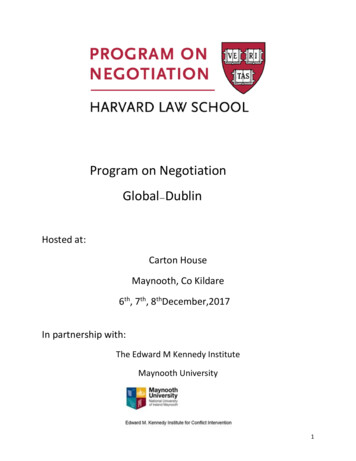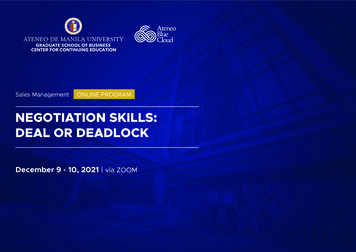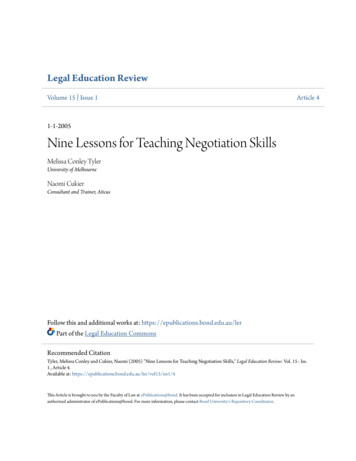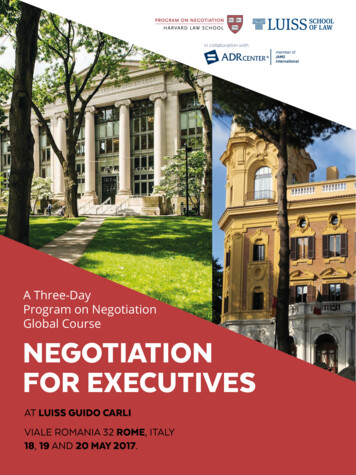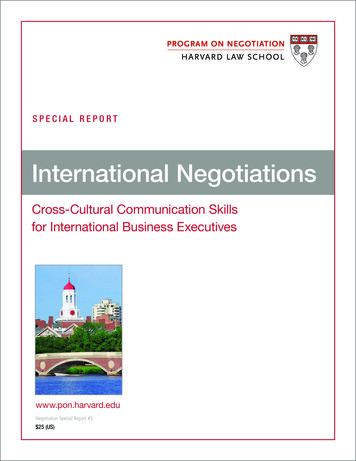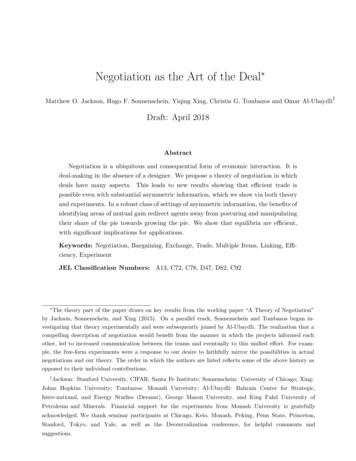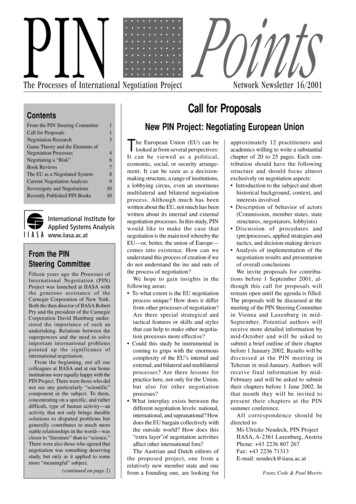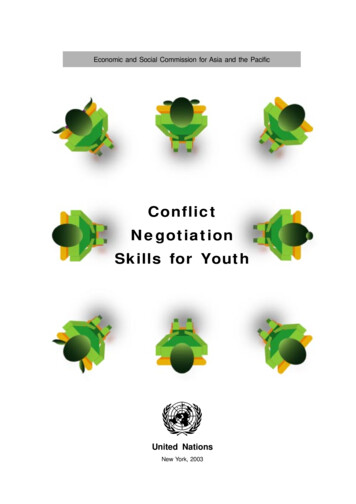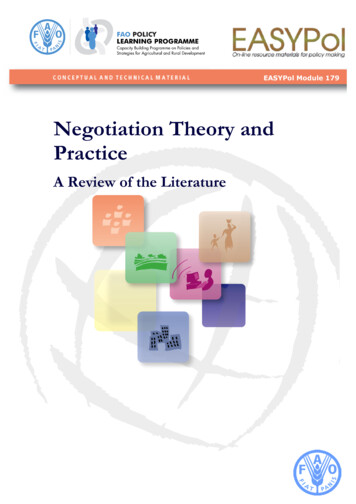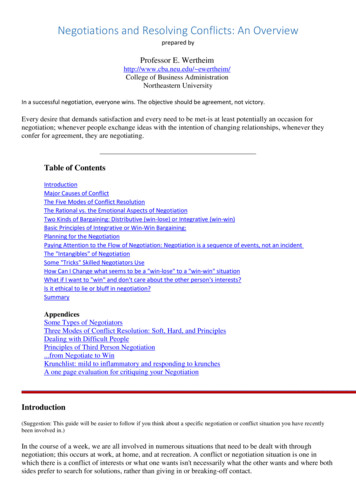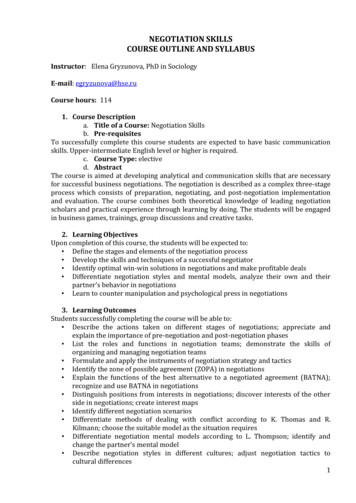
Transcription
NEGOTIATION SKILLSCOURSE OUTLINE AND SYLLABUSInstructor: Elena Gryzunova, PhD in SociologyE-mail: egryzunova@hse.ruCourse hours: 1141. Course Descriptiona. Title of a Course: Negotiation Skillsb. Pre-requisitesTo successfully complete this course students are expected to have basic communicationskills. Upper-intermediate English level or higher is required.c. Course Type: electived. AbstractThe course is aimed at developing analytical and communication skills that are necessaryfor successful business negotiations. The negotiation is described as a complex three-stageprocess which consists of preparation, negotiating, and post-negotiation implementationand evaluation. The course combines both theoretical knowledge of leading negotiationscholars and practical experience through learning by doing. The students will be engagedin business games, trainings, group discussions and creative tasks.2. Learning ObjectivesUpon completion of this course, the students will be expected to: Define the stages and elements of the negotiation process Develop the skills and techniques of a successful negotiator Identify optimal win-win solutions in negotiations and make profitable deals Differentiate negotiation styles and mental models, analyze their own and theirpartner’s behavior in negotiations Learn to counter manipulation and psychological press in negotiations3. Learning OutcomesStudents successfully completing the course will be able to: Describe the actions taken on different stages of negotiations; appreciate andexplain the importance of pre-negotiation and post-negotiation phases List the roles and functions in negotiation teams; demonstrate the skills oforganizing and managing negotiation teams Formulate and apply the instruments of negotiation strategy and tactics Identify the zone of possible agreement (ZOPA) in negotiations Explain the functions of the best alternative to a negotiated agreement (BATNA);recognize and use BATNA in negotiations Distinguish positions from interests in negotiations; discover interests of the otherside in negotiations; create interest maps Identify different negotiation scenarios Differentiate methods of dealing with conflict according to K. Thomas and R.Kilmann; choose the suitable model as the situation requires Differentiate negotiation mental models according to L. Thompson; identify andchange the partner’s mental model Describe negotiation styles in different cultures; adjust negotiation tactics tocultural differences1
Explain the role of the media and external interest groups in negotiations; preparePR and media relations plans to support the negotiation processFormulate objective and subjective trust-building factors; apply trust-buildingmethods in negotiationsPerform persuasive speech techniquesUse the methods and algorithms of revealing and countering manipulationFormulate and apply psychological principles of successful negotiationsPractice methods of transactional analysis for establishing constructive dialogue4. Course Plan#TopicTotalhours1Introduction. What isnegotiation?Preparing thenegotiationsIn the room: theactual ipulation andpsychological pressPost-negotiationstageSpecial negotiationcasesTotal:12234567In-class workOut-of-classLectures Seminars Practice 21211412Topic # 1. Introduction. What is negotiation? Definition Negotiation vs other social interactions Aspects of negotiation research and practice Aspects of negotiationTopic # 2. Preparing the negotiations Goal-setting: identifying your goals, options and criteria of success Identifying your BATNA (best alternative to a negotiated agreement) and ZOPA(zone of possible agreement) Assessing the other side, red-teaming Learning about catalysts and barriers of successful collaboration Designing a negotiation plan Creating a negotiation teamTopic # 3. In the room: the actual negotiation stage 3 phases of actual negotiations: initial phase, exploratory phase and finalization2
Rational and emotional elements of trust, cultural and psychological differences oftrusting peopleTactics for promoting a constructive negotiation climatePositions and interests in negotiations4 negotiation scenarios: win-win, win-lose, lose-win, lose-loseThe Thomas-Kilmann Conflict Mode Instrument in negotiationsLeigh Thompson’s 5 negotiation mental modelsNegotiation stylesPersuasion techniquesInstruments of negotiationsThe role of outside actors in negotiations: the media and interest groupsFinalization: overcoming impasseReaching an agreement, types of agreementsTopic # 4. Negotiation strategies Positional bargaining Principled negotiations by Roger Fisher and William Ury Mixed negotiating by Willem Mastenbroek 3-D Negotiation by David Lax and James SebeniusInterim assessment: colloquiumTopic # 5. Countering manipulation and psychological press The methods and algorithms of revealing and countering manipulation Transactional analysis in negotiationsTopic # 6. Post-negotiation stage Implementation and compliance Post-negotiation assessment and evaluationTopic # 7. Special negotiation cases International and cross-cultural negotiations Crisis negotiationsFinal assessment: exam5. Reading Lista. Required Berghoff, E. A. et al. (2007). The International Negotiations Handbook. Successthrough Preparation, Strategy, and Planning. PILPG and Baker & McKenzie.Online Services/bk internationalnegotiationshandbook 12.pdf Fisher, R., Ury, W. (2012). Getting to Yes. Business BooksRussian editions: Фишер Р., Юри У. Путь к согласию, или переговоры без поражения.М.: 1992 Фишер, Р., Юри У. Переговоры без поражения: Гарвардский метод.М.: Эксмо, 2007 Jensen, K. (2013). The Trust Factor: Negotiating in SMARTnership. PalgraveMacmillan.Online access: http://proxylibrary.hse.ru:2099/toc.aspx?bookid 894653
Lax, D. A., and Sebenius, J. K. (2006). 3-D Negotiation: Powerful Tools to Changethe Game in Your Most Important Deals. Harvard Business Press.Online access: http://proxylibrary.hse.ru:2099/toc.aspx?bookid 40523Lewis, R. D. (2006). When Cultures Collide: Leading Across Cultures. Boston:Nicholas Brealey International.Online access: http://proxylibrary.hse.ru:2099/toc.aspx?bookid 13710Lyons, C. (2009). I Win, You Win: The Essential Guide to Principled Negotiation.A&C Black Business Information and Development.Online l.action?docID 10196642&p00 negotiationMastenbroek, W. (1999). Negotiating as Emotion Management // Theory, Culture& Society. Vol. 16 (4). P. 49-73.Online 4/49.full.pdf htmlTracy, B. (2013). Negotiation. AMACOM.Online access: http://proxylibrary.hse.ru:2099/toc.aspx?bookid 54339b. OptionalЛебедева М. М. Технология ведения переговоров. М.: Аспект Пресс, 2010.Adair, W. L. & Brett, J. M. (2005). The Negotiation Dance: Time, Culture andBehavioral Sequence in Negotiation // Organization Science, 16 (1).Barge, J. K. (2009). Negotiation Theory. In: Littlejohn, S. W., and Foss, K. A. (eds.).Encyclopedia of Communication Theory. SAGE Publications.Berne, E. (1961). Transactional Analysis in Psychotherapy: A SystematicIndividual and Social Psychiatry. New York: Grove PressRussian edition: Берн Э. Трансактный анализ в психотерапии. М.:Академический проект, 2001.Boven, L. van and Thompson, L. (2003). Look into the Mind of the Negotiator:Mental Models in Negotiation // Group Processes & Intergroup Relations, Vol. 6(4), p. 387 – 404.Online access: ll.pdf htmlCarr, A. (1969). Business as a Game. Signet.Cohen, S. (2002). Negotiating Skills for Managers. McGraw-Hill.Craver, C. B. (2012). The Benefits to Be Derived from Post-NegotiationAssessments. GW Law Faculty Publications & Other Works. Paper 464.Online access: http://scholarship.law.gwu.edu/faculty publications/464Fisher, R. and Shapiro, D. (2005). Beyond Reason. Penguin Books.Gelfand, M. J., and Brett, J. M., eds. (2004). The Handbook of Negotiation andCulture. Stanford University Press.Online access: http://proxylibrary.hse.ru:2099/toc.aspx?bookid 10333Gilboa, E. (2001). Diplomacy in the Media Age: Three Models of Uses and Effects// Diplomacy and Statecraft, Vol. 12, No. 2. P. 1-28.Online 09592290108406201Hall E. Beyond Culture. N. Y.: Anchor Books, 1976.Mastenbroek, W. (1989). Negotiate. Oxford: Blackwell PublishingRussian edition: Мастенбрук В. Переговоры. Калуга: Калужский Институтсоциологии, 1993Mastenbroek, W. (2012). Negotiating as Emotion Management. ManagementSiteNetwerk.4
Rosenthal, U., ’t Hart, P. and Kouzmin, A. (1991). The Bureaupolitics of CrisisManagement // Public Administration, No. 69, p. 211-233.Sally, D., and O'Connor, K. (2004). Team Negotiations // Marquette Law Review,Vol. 87, Issue 4. P. 883-892.Shostrom, E. (1979). Man, the Manipulator: The Inner Journey fromManipulation to Actualization. New York: Bantam BooksRussian edition: Шостром Э. Человек - манипулятор. Внутреннеепутешествие от манипуляции к актуализации. К.: PSYLIB, 2003Starkey, B., Boyer, M. A. and Wilkenfeld, J. (2010). International Negotiation in aComplex World. Rowman & Littlefield PublishersStewart, I. and Joines, V. TA Today: A New Introduction to TransactionalAnalysis. Nottingham and Chapel Hill: Life Space Publishing, 1987Russian edition: Стюарт Я., Джойнс В. Современный транзактный анализ. С.Петербург: Социально-психологический центр, 1996Thomas, K. and Kilmann, R. (1974). The Thomas-Kilmann Conflict ModeInstrument. Tuxedo Park, N.Y.: Xicom, Inc.Thompson, L., and Loewenstein, J. (2003). Mental Models of Negotiations;Descriptive, Prescriptive and Paradigmatic Implications. In: Hogg, M. A., andCooper, J. (eds.). SAGE Handbook of Social Psychology. London: Sage. P. 494-511.Thompson, L. (2015). The Mind and Heart of the Negotiator. Pearson EducationLimited.Thompson, L. (2013). The Truth about Negotiations. New Jersey: PearsonEducation, Inc.Thompson, L. Wang, J., and Gunia, B. (2010). Negotiation // Annual Review ofPsychology, 2010. No. 61, p. 491–515Ury, W. (1991). Getting Past No: Negotiating With Difficult People. New York:Bantam BooksRussian edition: Юри У. Преодолевая "нет", или Переговоры с труднымилюдьми. М.: "Наука", 1993Ury, W. (2007). The Power of a Positive No. Hodder & Stoughton.Van Santen, W., Jonker, C. and Wijngaards, N. (2009). Crisis Decision MakingThrough a Shared Integrative Negotiation Mental Model // Landgren, Jonas andJul, Susanne. (eds.). Proceedings of the 6th International ISCRAM Conference Gothenburg, SwedenOnline /Contributions/215 Crisis%20Decision%20Making%20Through%20a%20Shared van%20Santen2009.pdfWilson, E., and Thompson, L. (2014). Creativity and Negotiation Research: theIntegrative Potential // International Journal of Conflict Management, Vol. 25,Issue 4, p. 359 – 386Young, M. & Schlie, E. (2011). The Rhythm of the Deal: Negotiation as a Dance //Negotiation Journal, 27 (2).6. Grading SystemGrades in this course will be determined by the following criteria:ProjectScaleValueOut-of-class work0-10points0,2 of the interim assessment gradeIn-class participation and0-100,4 of the interim assessment grade5
activitiespointsColloquium0-10points0,4 of the interim assessment gradeTotal value of the interim assessment:0,4 of the final assessment grade0-10pointsFinal exam0,6 of the final assessment gradeRounding of grades: upwards (in favor of a student)GRADING SCALEStudents will earn their grade for this class based on the following system:Total value8-10 points6-7 points4-5 points1-3 Formula of the final assessment grade:Gfinal 0,4* Ginterim 0,6 *·GexamFormula of the interim assessment grade:Ginterim 0,4* Gformative 0,4 *·Gin-class 0,2 *·Gout-of-classFormula of the formative assessment grade:Gformative 1 * Gcolloquium7. Guidelines for Knowledge AssessmentStudents’ grade for the course depends on in-class participation and activities, out-of-classwork, colloquium and final written exam.Interim knowledge assessment form is colloquium which is in-class oral questions andanswers. If a student is absent on the date of the colloquium he or she is given zero pointsfor this assessment.In-class participation and activities include discussions, exercises, sharing personalreflections and experiences. Students get grades for every seminar then total grade for thein-class participation is counted. If a student is physically present most time of the seminar,attentive and willing to participate in all activities he or she gets excellent mark for theseminar. A student who is absent gets zero mark for the seminar.6
Out-of-class work includes in-home preparation of reports, presentations and othercreative assignments. A student can make a report on a particular subject and present it inclass. The topics of out-of-class assignments are given before the seminar when thepresentation is due. A student who is willing to present at the next seminar should informthe course instructor. Postponing the presentation is possible if the student is absent or notprepared but 1 point will be deducted from the grade. If a student does not present in classhe or she may send his or her written assignment to the instructor but 3 points will bededucted from the grade. Each student prepares one out-of-class assignment.Final assessment will be held in form of a written in-class answer to an examinationquestion.Sample colloquium questions:1. How can you define negotiation? What are the main characteristics of negotiation asa social interaction? How does it differ from other social interactions like fighting(competing) and cooperating (accommodating)? Can you give any examples of othersocial interactions? May negotiation include characteristics of other socialinteractions? Can a social interaction look like negotiation by form but be anotherkind of social interaction by substance? Can you give any examples?2. What are the stages and phases of a negotiation process? Describe briefly theactivities on each of these stages and phases.3. Do you think it is important to prepare before negotiations? Enumerate anddescribe briefly the preparation activities.4. Describe in detail the analytical part of preparation which includes identifying yourgoals, options and criteria of success, analyzing issues and alternatives.5. Describe in detail the analytical part of preparation which includes assessing theother side. What is important to find out about the other party before negotiations?How is it possible to do it? Which instruments and sources of information wouldyou use?6. What is BATNA and what are its functions in negotiations? What are the ways toidentify your BATNA? How to research the other party’s presumable BATNA? Howto speak about your BATNA in negotiations?7. What functions exist in negotiation teams? What are the advantages and risks ofteam negotiations?8. According to Roger Fisher and William Ury, what are the main disadvantages ofpositional bargaining? Do you agree with their critical remarks? If you agree, can you give an example (either cited by W. Fisher and W. Ury,or your own) when positional bargaining was ineffective? If you don’t agree with the authors, can you cite an example when positionalbargaining was effective?9. What are the 4 principles of the negotiation strategy described by Roger Fisher andWilliam Ury? Name and describe them briefly. Do you find these principleseffective? Explain why. Which of them do you find the most useful and why?10. Describe the principle of separating people from the problem by Roger Fisher andWilliam Ury. Do you find it useful and why? Do you find it sometimes difficult andwhy? Which tactics can be used to separate individuals from issues? Can you give ashort example of a negotiation situation (either real or imagined) when thisprinciple helped to make progress?11. Which are the most common “people problems” (human-factor problems) innegotiations, according to Roger Fisher and William Ury? What tactics are used to7
overcome these problems? Did you come across any of these problems in your lifeand how do you usually manage them?12. Describe the principle of focusing on interests, not positions by Roger Fisher andWilliam Ury. Do you find it useful and why? Do you find it sometimes difficult andwhy? How is it possible to identify interests and talk about interests in negotiation?Can you give a short example of a negotiation situation (either real or imagined)when this principle helped to make progress?13. Describe the principle of inventing options for mutual gain by Roger Fisher andWilliam Ury. Do you find it useful and why? Do you find it sometimes difficult andwhy? What tactics and instruments are proposed by the authors to multiply optionsin negotiations? Can you give a short example of a negotiation situation (either realor imagined) when this principle helped to make progress?14. Describe the principle of using objective criteria in negotiation by Roger Fisher andWilliam Ury. Do you find it useful and why? Do you find it sometimes difficult andwhy? What are the characteristics of objective criteria? Which kinds of objectivecriteria can you enumerate?15. Describe briefly the strategy of mixed negotiating by Willem Mastenbroek. What arethe 4 core activities and negotiator’s dilemmas? How does a negotiator need to dealwith these 4 dilemmas to perform effectively according to Willem Mastenbroek’srecommendations? What are the general tactics of mixed negotiating? Why does thisstrategy require emotion management? Do you find this strategy useful? Do youagree with the way Willem Mastenbroek advises to deal with the 4 dilemmas?16. What kinds of activities are used by a negotiator to obtain substantial results,according to Willem Mastenbroek? Describe the dilemma a negotiator faces relatingto these activities? How do you usually solve this dilemma in negotiations? Describedifferent tactics used by negotiators to achieve substantial results, according toWillem Mastenbroek? Do you find these tactics effective and why?17. What kind if activities are used by a negotiator to influence the balance of power,according to Willem Mastenbroek? Is balance of power important in negotiationsand why? Describe the dilemma a negotiator faces relating to these activities? Howdo you usually solve this dilemma in negotiations? Describe different tactics used bynegotiators to influence the balance of power. Do you find these tactics effective andwhy?18. What kind if activities are used by a negotiator to promote a constructive climate,according to Willem Mastenbroek? Is constructive climate important in negotiationsand why? Describe the dilemma a negotiator faces relating to these activities? Howdo you usually solve this dilemma in negotiations? Describe different tactics used bynegotiators to promote a constructive climate (possibly not only the tacticspresented by Willem Mastenbroek). Do you find these tactics effective and why?19. What kind if activities are used by a negotiator to obtain flexibility, according toWillem Mastenbroek? Is flexibility important in negotiations and why? Describe thedilemma a negotiator faces relating to these activities? How do you usually solvethis dilemma in negotiations? Describe different tactics used by negotiators toobtain flexibility (possibly not only the tactics presented by Willem Mastenbroek).Do you find these tactics effective and why?20. What are the 8 negotiation styles classified by Willem Mastenbroek? Which factorscan help to make assumptions about the other party’s negotiation style? WillemMastenbroek advises to mix negotiation styles for successful negotiations. Do youfind it difficult? What competences do you think are required in order to have aflexible negotiation style?8
21. What is the difference between positions and interests in negotiation? How doesWillem Mastenbroek describe the tactics of presenting your position in negotiation?What types of interests exist? Whose interests are important in negotiations?Describe instruments and tactics of exploring and discussing interests.22. Describe the problem of trust in negotiation. What are the factors of trust? What arethe ways of building and repairing trust? What factors of trust are important foryou? According to Willem Mastenbroek, to what extent should we trust thecounterparty in negotiations?23. What are the 5 core personal concerns in negotiation, according to Roger Fisher andDaniel Shapiro? Enumerate and describe them briefly. In your opinion, is itnecessary to take these concerns into account during negotiations? Do you (or willyou) address these core concerns of people you negotiate with and why? Which ofthese core concerns do you find the most important and why?24. What are the tactics of expressing appreciation to people you negotiate with,according to Roger Fisher and Daniel Shapiro? Do you find them useful? Why do youthink some people avoid expressing appreciation to people they don’t agree or haveconflicting interests with? Can you give a short example of a situation (either real orimagined) when expressing appreciation to the counterparty helped the negotiationto progress?25. What are the tactics of finding and building affiliation with people you negotiatewith, according to Roger Fisher and Daniel Shapiro? Do you find them useful? Canyou give a short example of a situation (either real or imagined) when buildingaffiliation helped the negotiation to progress? Are there any risks of buildingaffiliation to the other side in negotiations? How is it possible to avoid these risks?26. What do Roger Fisher and Daniel Shapiro understand by respecting autonomy innegotiation? Why is autonomy important to people? Whose autonomy should beconsidered in negotiation? What are the tactical activities to show respect for theirautonomy without risk to lose your own?27. What are the tactics of showing respect to the status of your counterparty innegotiations, according to Roger Fisher and Daniel Shapiro? Are there any risks ofshowing respect to the other’s status in negotiation? How is it possible to avoidthese risks?28. How can we meet our own and our counterparty’s core concern with having a rolethat is personally fulfilling during negotiations, according to Roger Fisher and DanielShapiro? What kind of conventional roles and temporary negotiation roles dopeople play? Why do you think this core concern is important? How would peoplebehave and feel if they don’t find their role fulfilling and why? What is your owntemporary negotiation role that you find fulfilling?29. What is the meaning of saving face in negotiations? Why is it important for somenegotiators to save their face? Why and in which situations a negotiator shouldbother about saving face of the other side? What are the tactics which may help tosave the face of your counterparty?30. Describe the 4 possible negotiation scenarios depending on the outcome for eachparty. Which are the factors that influence the negotiation scenario? What is youropinion on this classification?31. Describe briefly styles of behavior in a conflict of interest by Kenneth Thomas andRalph Kilmann. Which styles of behavior are more typical for you? Do you think it ismore effective to choose one style or combine different styles?32. Describe in detail avoiding style of behavior as a reaction to conflicting interests,according to Kenneth Thomas and Ralph Kilmann. In which situations avoiding maybe reasonable? What are the risks of avoiding?9
33. Describe in detail accommodating style of behavior as a reaction to conflictinginterests, according to Kenneth Thomas and Ralph Kilmann. In which situationsaccommodating may be reasonable? What are the risks of accommodating?34. Describe in detail competing style of behavior as a reaction to conflicting interests,according to Kenneth Thomas and Ralph Kilmann. In which situations competingmay be reasonable? What are the risks of competing?35. Describe in detail compromising style of behavior as a reaction to conflictinginterests, according to Kenneth Thomas and Ralph Kilmann. In which situationscompromising may be reasonable? What are the risks of compromising?36. Describe in detail collaborating style of behavior as a reaction to conflictinginterests, according to Kenneth Thomas and Ralph Kilmann. In which situationscollaborating may be reasonable? What are the risks of collaborating?37. Which negotiation strategy, tactics and instruments do you find the most effective?Which of them do you use (or will you use) in practice and why?Sample examination questions:1. Roger Fisher and William Ury: their contribution to negotiation theory and practice.2. Willem Mastenbroek: his contribution to negotiation theory and practice.3. David Lax and James Sebenius: their contribution to negotiation theory and practice.4. Stages and phases of the negotiation process.5. Preparing to negotiation: importance, preparation activities.6. BATNA.7. Negotiation teams.8. Positions and interests in negotiations.9. The problem of trust in negotiations.10. Styles of behavior in a conflict of interest by Kenneth Thomas and Ralph Kilmann.Their role in negotiations.11. Negotiation mental models by Leigh Thompson.12. Negotiation styles by Willem Mastenbroek.13. Persuasion and persuasive communication.14. Detecting and countering manipulation in negotiation.15. Use of transactional analysis and the ego-state models in negotiation.16. Principled negotiations.17. Positional bargaining.18. Win-win and win-lose negotiations.19. Basic negotiation skills and competences.20. 3-D Negotiation strategy.21. Making concessions in negotiations.22. Overcoming impasse in negotiations.23. Tactics of exploring and searching for alternatives in negotiations.24. Definition and characteristics of negotiation, its differences from other socialinteractions.25. Separating people from the problem in negotiations.26. Objective criteria in negotiations.27. 4 core activities and negotiator’s dilemmas by Willem Mastenbroek.28. Tactics of obtaining substantial results by Willem Mastenbroek.29. Tactics of influencing the balance of power by Willem Mastenbroek.30. Promoting constructive climate during negotiations.31. Tactics of obtaining flexibility, according to Willem Mastenbroek.10
32. 5 core personal concerns in negotiation, according to Roger Fisher and DanielShapiro.33. Saving face of the other side in negotiations.34. 3-D Barriers Audit in negotiations.35. The instrument of backward mapping in strategic negotiations by David Lax andJames Sebenius.36. Value-creating deals and the importance of “social contract” in negotiations.37. Types of emotional manipulators and manipulative tactics in negotiations.38. Types of agreements in negotiations.39. Implementation and evaluation of the negotiation results.40. Goals, criteria of success and breaking points in negotiations.41. Assessment of the other side in negotiations.42. Types of interests, their role in negotiations. Interest maps.43. Integrative negotiations: tactics of broadening options for mutual gain.44. Compromise in negotiations.45. Negotiation plan.46. Psychological competencies and skills of an effective negotiator.47. Communicative competencies and skills of an effective negotiator.48. Analytical competencies and skills of an effective negotiator.49. Strategic thinking in negotiation practice.50. Creative thinking in negotiation practice.8. Methods of InstructionThe course includes both theory and practice. Students will be engaged in various in-classtraining activities: simulations of negotiations, business games, case studies, groupdiscussions and creative tasks.9. Special Equipment and Software SupportComputer with power point and video software supportProjectorLoudspeakersFlip chart and markersBlackboard11
The course is aimed at developing analytical and communication skills that are necessary for successful business negotiations. The negotiation is described as a complex three-stage process which consists of preparation, negotiating
